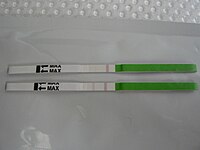Fertility monitor

A fertility monitor is something that helps people who want to have a baby know when the best time is to try to get pregnant. It does this by keeping track of a person's menstrual cycle, which is the pattern of bleeding that happens every month.
During a cycle, a person's body goes through different changes that make it easier or harder to get pregnant. One of these changes is when an egg is released from the ovaries, which is called ovulation. If a person has sex right around the time of ovulation, there is a better chance that the egg will be fertilized by the sperm and result in a pregnancy.
The fertility monitor helps keep track of when ovulation is occurring by measuring changes in the body's hormones. Hormones are like little messengers that tell different parts of the body what to do. In this case, the hormones that the fertility monitor checks are called luteinizing hormone (LH) and estrogen. These hormones increase in the body right before ovulation happens, which is when the fertility monitor will say that it's a good time to try to get pregnant.
There are different types of fertility monitors available, but some of them require using urine or saliva tests to check the hormones. Other monitors may track body temperature or changes in cervical mucus to determine when ovulation is happening.
By using a fertility monitor, people who want to have a baby can have a better idea of when it's the best time to try to get pregnant. This can help increase the chances of a successful pregnancy and make the process of trying to conceive easier and more predictable.
During a cycle, a person's body goes through different changes that make it easier or harder to get pregnant. One of these changes is when an egg is released from the ovaries, which is called ovulation. If a person has sex right around the time of ovulation, there is a better chance that the egg will be fertilized by the sperm and result in a pregnancy.
The fertility monitor helps keep track of when ovulation is occurring by measuring changes in the body's hormones. Hormones are like little messengers that tell different parts of the body what to do. In this case, the hormones that the fertility monitor checks are called luteinizing hormone (LH) and estrogen. These hormones increase in the body right before ovulation happens, which is when the fertility monitor will say that it's a good time to try to get pregnant.
There are different types of fertility monitors available, but some of them require using urine or saliva tests to check the hormones. Other monitors may track body temperature or changes in cervical mucus to determine when ovulation is happening.
By using a fertility monitor, people who want to have a baby can have a better idea of when it's the best time to try to get pregnant. This can help increase the chances of a successful pregnancy and make the process of trying to conceive easier and more predictable.
Related topics others have asked about:
